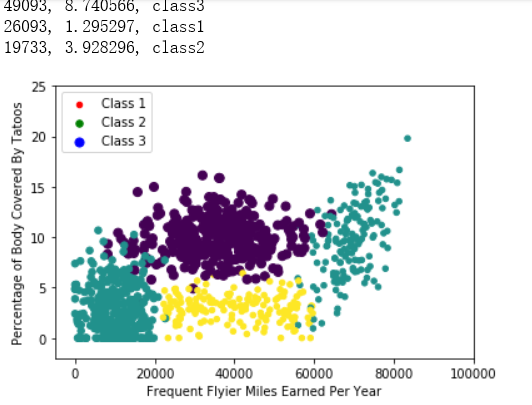吴裕雄 python 机器学习-KNN(2)
import matplotlib
import numpy as np
import matplotlib.pyplot as plt
from matplotlib.patches import Rectangle n = 1000 #number of points to create
xcord = np.zeros((n))
ycord = np.zeros((n))
markers =[]
colors =[]
fw = open('D:\\LearningResource\\machinelearninginaction\\Ch02\\EXTRAS\\testSet.txt','w') for i in range(n):
[r0,r1] = np.random.standard_normal(2)
myClass = np.random.uniform(0,1)
if (myClass <= 0.16):
fFlyer = np.random.uniform(22000, 60000)
tats = 3 + 1.6*r1
markers.append(20)
colors.append(2.1)
classLabel = 1 #'didntLike'
print(("%d, %f, class1") % (fFlyer, tats))
elif ((myClass > 0.16) and (myClass <= 0.33)):
fFlyer = 6000*r0 + 70000
tats = 10 + 3*r1 + 2*r0
markers.append(20)
colors.append(1.1)
classLabel = 1 #'didntLike'
print(("%d, %f, class1") % (fFlyer, tats))
elif ((myClass > 0.33) and (myClass <= 0.66)):
fFlyer = 5000*r0 + 10000
tats = 3 + 2.8*r1
markers.append(30)
colors.append(1.1)
classLabel = 2 #'smallDoses'
print(("%d, %f, class2") % (fFlyer, tats))
else:
fFlyer = 10000*r0 + 35000
tats = 10 + 2.0*r1
markers.append(50)
colors.append(0.1)
classLabel = 3 #'largeDoses'
print(("%d, %f, class3") % (fFlyer, tats))
if (tats < 0):
tats =0
if (fFlyer < 0):
fFlyer =0
xcord[i] = fFlyer
ycord[i]=tats
fw.write("%d\t%f\t%f\t%d\n" % (fFlyer, tats, np.random.uniform(0.0, 1.7), classLabel)) fw.close() fig = plt.figure()
ax = fig.add_subplot(111)
ax.scatter(xcord,ycord, c=colors, s=markers)
type1 = ax.scatter([-10], [-10], s=20, c='red')
type2 = ax.scatter([-10], [-15], s=30, c='green')
type3 = ax.scatter([-10], [-20], s=50, c='blue')
ax.legend([type1, type2, type3], ["Class 1", "Class 2", "Class 3"], loc=2)
ax.axis([-5000,100000,-2,25])
plt.xlabel('Frequent Flyier Miles Earned Per Year')
plt.ylabel('Percentage of Body Covered By Tatoos')
plt.show()

...................................................

import numpy as np
import matplotlib
import matplotlib.pyplot as plt
from matplotlib.patches import Rectangle n = 1000 #number of points to create
xcord1 = []; ycord1 = []
xcord2 = []; ycord2 = []
xcord3 = []; ycord3 = []
markers =[]
colors =[]
fw = open('D:\\LearningResource\\machinelearninginaction\\Ch02\\EXTRAS\\testSet.txt','w') for i in range(n):
[r0,r1] = np.random.standard_normal(2)
myClass = np.random.uniform(0,1)
if (myClass <= 0.16):
fFlyer = np.random.uniform(22000, 60000)
tats = 3 + 1.6*r1
markers.append(20)
colors.append(2.1)
classLabel = 1 #'didntLike'
xcord1.append(fFlyer)
ycord1.append(tats)
elif ((myClass > 0.16) and (myClass <= 0.33)):
fFlyer = 6000*r0 + 70000
tats = 10 + 3*r1 + 2*r0
markers.append(20)
colors.append(1.1)
classLabel = 1 #'didntLike'
if (tats < 0):
tats =0
if (fFlyer < 0):
fFlyer =0
xcord1.append(fFlyer)
ycord1.append(tats)
elif ((myClass > 0.33) and (myClass <= 0.66)):
fFlyer = 5000*r0 + 10000
tats = 3 + 2.8*r1
markers.append(30)
colors.append(1.1)
classLabel = 2 #'smallDoses'
if (tats < 0):
tats =0
if (fFlyer < 0):
fFlyer =0
xcord2.append(fFlyer)
ycord2.append(tats)
else:
fFlyer = 10000*r0 + 35000
tats = 10 + 2.0*r1
markers.append(50)
colors.append(0.1)
classLabel = 3 #'largeDoses'
if (tats < 0): tats =0
if (fFlyer < 0): fFlyer =0
xcord3.append(fFlyer)
ycord3.append(tats)
fw.write("%d\t%f\t%f\t%d\n" % (fFlyer, tats, np.random.uniform(0.0, 1.7), classLabel)) fw.close()
fig = plt.figure()
ax = fig.add_subplot(111)
# ax.scatter(xcord,ycord, c=colors, s=markers)
type1 = ax.scatter(xcord1, ycord1, s=20, c='red')
type2 = ax.scatter(xcord2, ycord2, s=30, c='green')
type3 = ax.scatter(xcord3, ycord3, s=50, c='blue')
ax.legend([type1, type2, type3], ["Did Not Like", "Liked in Small Doses", "Liked in Large Doses"], loc=2)
ax.axis([-5000,100000,-2,25])
plt.xlabel('Frequent Flyier Miles Earned Per Year')
plt.ylabel('Percentage of Time Spent Playing Video Games')
plt.show()

import numpy as np
import matplotlib
import matplotlib.pyplot as plt def file2matrix(filename):
fr = open(filename)
returnMat = []
classLabelVector = [] #prepare labels return
for line in fr.readlines():
line = line.strip()
listFromLine = line.split('\t')
returnMat.append([float(listFromLine[0]),float(listFromLine[1]),float(listFromLine[2])])
classLabelVector.append(int(listFromLine[-1]))
return np.array(returnMat),np.array(classLabelVector) fig = plt.figure()
ax = fig.add_subplot(111)
datingDataMat,datingLabels = file2matrix('D:\\LearningResource\\machinelearninginaction\\Ch02\\datingTestSet2.txt')
#ax.scatter(datingDataMat[:,1], datingDataMat[:,2])
ax.scatter(datingDataMat[:,1], datingDataMat[:,2], 15.0*np.array(datingLabels), 15.0*np.array(datingLabels))
ax.axis([-2,25,-0.2,2.0])
plt.xlabel('Percentage of Time Spent Playing Video Games')
plt.ylabel('Liters of Ice Cream Consumed Per Week')
plt.show()

吴裕雄 python 机器学习-KNN(2)的更多相关文章
- 吴裕雄 python 机器学习——KNN回归KNeighborsRegressor模型
import numpy as np import matplotlib.pyplot as plt from sklearn import neighbors, datasets from skle ...
- 吴裕雄 python 机器学习——KNN分类KNeighborsClassifier模型
import numpy as np import matplotlib.pyplot as plt from sklearn import neighbors, datasets from skle ...
- 吴裕雄 python 机器学习-KNN算法(1)
import numpy as np import operator as op from os import listdir def classify0(inX, dataSet, labels, ...
- 吴裕雄 python 机器学习——半监督学习LabelSpreading模型
import numpy as np import matplotlib.pyplot as plt from sklearn import metrics from sklearn import d ...
- 吴裕雄 python 机器学习——半监督学习标准迭代式标记传播算法LabelPropagation模型
import numpy as np import matplotlib.pyplot as plt from sklearn import metrics from sklearn import d ...
- 吴裕雄 python 机器学习——分类决策树模型
import numpy as np import matplotlib.pyplot as plt from sklearn import datasets from sklearn.model_s ...
- 吴裕雄 python 机器学习——回归决策树模型
import numpy as np import matplotlib.pyplot as plt from sklearn import datasets from sklearn.model_s ...
- 吴裕雄 python 机器学习——线性判断分析LinearDiscriminantAnalysis
import numpy as np import matplotlib.pyplot as plt from matplotlib import cm from mpl_toolkits.mplot ...
- 吴裕雄 python 机器学习——逻辑回归
import numpy as np import matplotlib.pyplot as plt from matplotlib import cm from mpl_toolkits.mplot ...
随机推荐
- 通过mapreduce把mysql的一张表的数据导到另外一张表中
怎么安装hadoop集群我在这里就不多说了,我这里安装的是三节点的集群 先在主节点安装mysql 启动mysql 登录mysql 创建数据库,创建表格,先把数据加载到表格 t ,表格t2是空的 mys ...
- angularjs中阻止事件冒泡,以及指令的注意点
appModule.directive('newStr',function(){ return{ restrict:'AE', //阻止事件冒泡需要加$event参数 template:`<di ...
- python- 日志学习
# @File : learn_logging.py #-*- coding:utf-8 -*- """ 日志:log 记录代码执行的过程 一旦记录下来,就可以根据日志去 ...
- java类库 collection与collections (转)
http://www.cnblogs.com/dashi/p/3597937.html Java中Collection和Collections的区别 1.java.util.Collection 是一 ...
- [Unity插件]Lua行为树(十一):组合节点Parallel
Parallel节点类似Sequence节点,不同在于Parallel会每帧执行所有的节点.当所有节点返回成功时返回成功,当其中一个节点返回失败时,返回失败并且结束所有的子节点运行. 例如说,给Seq ...
- 怎么分辨是eclipse还是 android studio开发的
eclipse开发的一般都会带.classpath文件.Android studio开发的一般都会有.gradle文件夹和build.gradle文件
- [Android] android.util.Log
android.util.Log常用的方法有以下5个:Log.v() Log.d() Log.i() Log.w() 以及 Log.e() .根据首字母对应VERBOSE,DEBUG,INFO, W ...
- uva-10026-贪心
题意:有N项工作,每项工作完成需要n天,如果不开始做每天罚fee,开始做即不罚钱,求任务的执行顺序,使得罚钱最少.如果有多组答案,取下标排列最小的那组 解题思路: 考虑工作tn(dn,fn) , 假如 ...
- 关于dumper和mysqldump的
最近在做版本更新 使用dumper在连接阿里云的RDS的时候 老是提示 需要超级管理员权限 无能只能使用系统自带的mysqldump了 语句简单方便 而且导出的表 没有加载库信息 mysqldump ...
- http etag
基础知识 1) 什么是”Last-Modified”? 在浏览器第一次请求某一个URL时,服务器端的返回状态会是200,内容是你请求的资源,同时有一个Last-Modified的属性 ...
